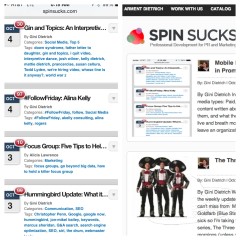In the agency world, we talk a lot about the four media types: Paid, earned, owned, and shared. There is lots of content written about how to use each of the four, how to integrate them, and what they mean for increased revenue.
But, unless you live and breath mobile marketing, it’s rare for that conversation to leave an organization’s website and reach it’s mobile site (assuming, of course, there is a mobile site).
Do I Need a Mobile Site?
During a Marketing Over Coffee episode this summer, Christopher Penn and John Wall talked about how to know when it’s time to build a mobile site.
Go into Google analytics and click on audience, mobile, overview. Set your date range for the past month. If less than 10 percent of people are visiting your site on their phones or tablets, you’re still okay not to have a mobile site…yet. Though you should consider responsive design, at the very least.
If more than 10 percent are using their mobile devices to visit your site, you’re behind the curve ball and need to consider a site specific to those visitors.
The Spin Sucks mobile visitors are nearly 30 percent, which is why you have a different experience there than on your computer (see image above; the mobile site is on the left and the website is on the right).
Marketing Your Mobile Site
As you build your mobile site, you have to think about advertising options that introduce your app, product, service, or organization to a wider audience. You have to think about ways you can improve what you’re selling through content you create to increase awareness, and usage, trials, and/or sales. You have to think about how to engage current customers or users in social spaces to help you spread the word. And you have to think about what will interest journalists and bloggers to help you tell your story.
The key, of course, is to strike the right balance to achieve your goals.
Use Paid Media Cost Efficiently
In many cases, paid media is out of reach for organizations. Let’s say, for example, you have an app and you want to get it into the top one or two pages of your key category. A display media blitz might be too expensive on iTunes.
What do you do?
Look for more affordable paid media options where people might look for what you’re selling online such as review sites, forums, discussion groups, and communities.
Buy ads on review sites, on YouTube channels that have something to do with your industry, and sponsor Facebook or Twitter posts.
Integrate with Owned Media
If you have an app, you want to optimize your landing page with iTunes. This, of course, isn’t technically owned media because iTunes owns it…not you. But an estimate 80 percent of app search happens within the app store so be sure your landing page is up to snuff.
If you don’t have an app, you can do something similar with your mobile site. Consider the following:
- Use the same keywords you use in your paid media on your mobile site
- Create a landing page that is specific to your product or service
- Have contextual calls-to-action that drive people back to the landing pages
- Create content that is interesting, valuable, and engaging for your visitors…and is something different than they can get on your website
Use Earned Media
There are right ways and wrong ways to work with influential bloggers and journalists.
The wrong way is to go online, Google “how to write a news release,” create one, and then send it to everyone you can find who might write about what you do.
The right way is to build relationships with the people who can help you. Just like you wouldn’t go to a networking event, introduce yourself to someone new, and ask them to buy your product, the same goes with earned media.
Figure out who you think can help you, comment on their content, share it, find something in common, and build a relationship. They’ll be much more willing to help you if they consider you a friend (even an online friend) than if you pitch them blindly.
When stories and blog posts do run, make sure there are links to your app landing page or to your mobile website.
Follow-Up with Shared Media
It’s likely not a surprise the most effective shared media tactic is to integrate social tools into your mobile website. This turns every visitor into a brand ambassador and every social share into an endorsement.
You’d think this would go without saying in 2013, but do a test on your own. Look at 10 mobile websites. How many have social share buttons? I’m willing to guess not even half.
Of course, you have to orchestrate all of this to work together and at once. It will look like – to the outside world – you came out of nowhere. To make it look that way takes a good six to nine months of preparation.
Give yourself enough time, plan, and execute flawlessly.
A very loose version of this first appeared on the Mobile Retail blog.
